the UCLA Chicano Studies Research Center,
the Arhoolie Foundation,
and the UCLA Digital Library
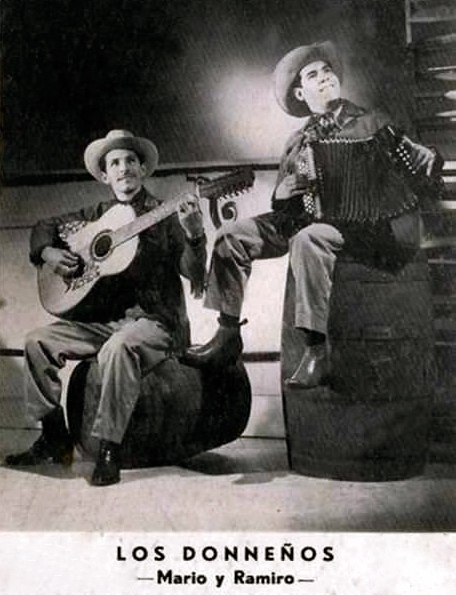 Los Donneños, a duet formed in the late 1940s in the Rio Grande Valley of South Texas, were pioneers in the evolution of norteño music during the 1950s. They went on to become one of the first Tex-Mex acts to find major success on both sides of the border.
Los Donneños, a duet formed in the late 1940s in the Rio Grande Valley of South Texas, were pioneers in the evolution of norteño music during the 1950s. They went on to become one of the first Tex-Mex acts to find major success on both sides of the border.
The historic duet was formed by two musicians, Ramiro Cavazos on guitar and Mario Montes on accordion. They both hailed from the Mexican border state of Nuevo Leon, but they met only after moving to the U.S. side of the Rio Grande.
Cavazos was born in 1927 in Garza Ayala, a rural community on the road between Monterrey, Mexico, and Laredo, Texas. Montes was born four years earlier in General Terán, southwest of Monterrey, home to another famed norteño group from the same period, Los Alegres de Terán, Tomás Ortiz and Eugenio Abrego. In fact, in the early years of both acts, Cavazos performed with Los Alegres and actually recorded with them on several 78s for the Orfeo label, billing themselves as Ortiz y Cavazos con el Dueto Abrego.
Cavazos and Montes immigrated separately to the United States and met in the sleepy town of Donna, Texas, named after the daughter of an early frontier developer, Thomas Jefferson Hooks. When they arrived in the late 1940s, the town of some 5,000 residents still had schools with three tiers of segregation: whites, Mexicans, and migrants.
In Donna, both musicians held day jobs while pursuing their passion for music—Montes picking fruit in the fields and Cavazos washing dishes at a small restaurant for $14 a week.
More than 60 years later, Cavazos still fondly recalled the first time he met his future partner, as he told journalist Eduardo Martinez in a 2012 interview published by The Monitor of McAllen, Texas. He said he was riding his bicycle one day when he saw two men playing music on the street. When Cavazos approached, one of the men, who turned out to be Montes, asked if he was a musician. Yes, Cavazos said, he played the guitar and sang. That’s all it took to strike up a lifelong musical partnership.
Cavazos and Montes made their first recordings in 1947 for Discos Falcon, based in McAllen. According to an article in El Extra, a news website in South Texas, the initial tracks were “Ojos Negros Nunca Engañan” (Dark Eyes Never Lie) and “El Corrido De Bernabé Mata,” released on 78-rpm disc the following year. However, the Frontera Collection has a different song on the flip side of the duo’s debut disc – “Así Se Baila en Reynosa” (This is How They Dance in Reynosa). The aforementioned corrido is cited incorrectly; it’s actually titled “Bernardo Mata” and is a popular ballad that appears in the Frontera archive by a dozen different artists. In the database, recordings of the corrido by Los Donneños include a 45-rpm single and an album track on a greatest-hits compilation, both on Falcon’s Bronco imprint. 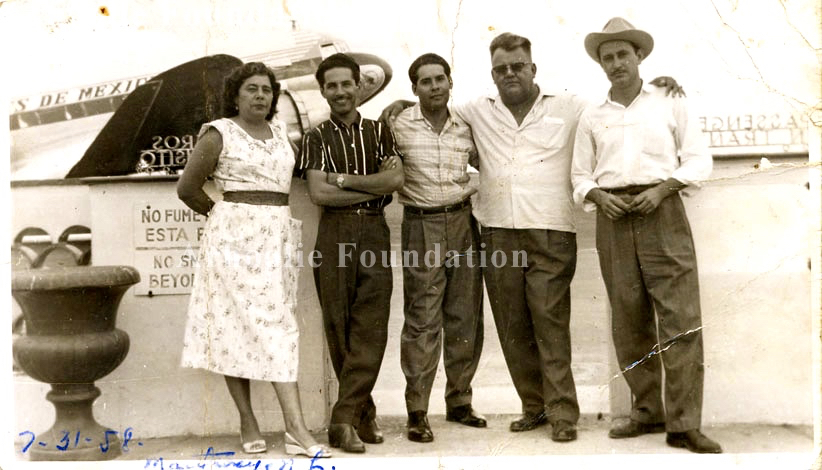
The group’s early recordings featured Cavazos on guitar rather than the traditional bajo sexto. But he would soon take up the 12-string guitar commonly used in conjunto music because he said it had a stronger and more appealing sound. He won acclaim for his style on the instrument, which played bass lines against the accordion in these early duets.
Following that first recording session, Falcon label owner Arnaldo Ramirez dubbed the new act Los Donneños, based on the fact that they were residing in Donna. The artists were perplexed, however, because they were actually from Mexico and had just recently moved to their namesake city, and didn’t stay there long. But the name stuck, as if they were native sons.
Still, their partnership remained fluid in the early days.
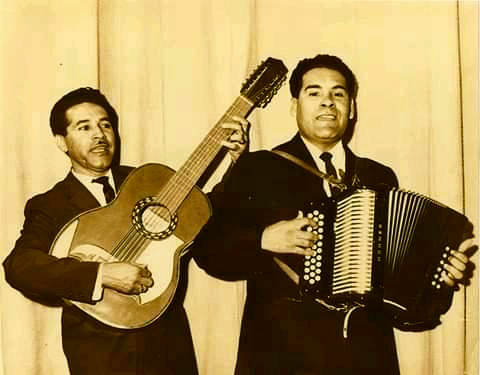 Montes soon married a U.S. citizen and legalized his status. Meanwhile, Cavazos, who remained undocumented until 1954, would spend time across the border in Reynosa, Tamaulipas. There, just across the river from McAllen, he played guitar with Los Alegres, performed constantly, and made good money. The musician recalled that heady time in an interview with Frontera Collection founder Chris Strachwitz, who wrote liner notes for a 2006 retrospective album, Los Donneños: Grabaciones Originales/Historic First Recordings, 1950-1954 (Arhoolie 9057).
Montes soon married a U.S. citizen and legalized his status. Meanwhile, Cavazos, who remained undocumented until 1954, would spend time across the border in Reynosa, Tamaulipas. There, just across the river from McAllen, he played guitar with Los Alegres, performed constantly, and made good money. The musician recalled that heady time in an interview with Frontera Collection founder Chris Strachwitz, who wrote liner notes for a 2006 retrospective album, Los Donneños: Grabaciones Originales/Historic First Recordings, 1950-1954 (Arhoolie 9057).
“Around 1950, Ramiro made more records with Tomas Ortiz for the Orfeo label but earned his living playing weddings, quinceafieras, and on weekends in the cantinas,” Strachwitz wrote. “Ramiro said that in those beer joints there was plenty of money to be made from the Braceros who had come back from the cotton fields of Texas and wouldn't let the musicians go until two or three in the morning. They charged three Mexican pesos per song and made about 40 or 50 pesos each per night, with which he says you could live like a king!”
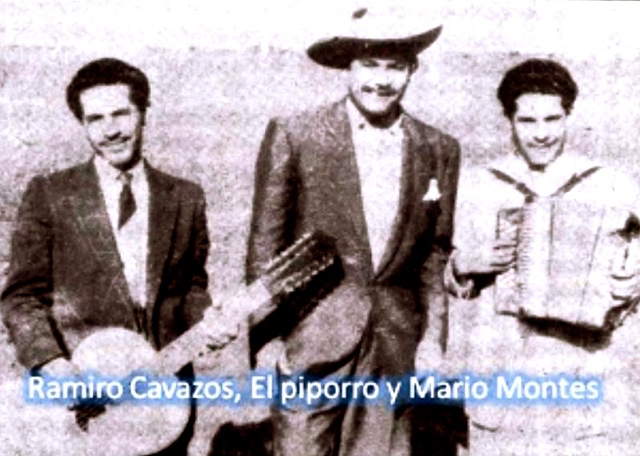 Later in the 1950s, Cavazos and Montes appeared in five films along with the colorful norteño singer and movie star Lalo Gonzalez, a.k.a. "El Piporro." In this clip from the 1959 film Dos Corazones y un Cielo, the duo expertly accompanies the showy star on the comically flirtatious ditty, “Las Quedadas” (The Spinsters). Piporro also took Los Donneños on tour as his backup group throughout the United States, Venezuela, and Cuba, boosting their popularity internationally.
Later in the 1950s, Cavazos and Montes appeared in five films along with the colorful norteño singer and movie star Lalo Gonzalez, a.k.a. "El Piporro." In this clip from the 1959 film Dos Corazones y un Cielo, the duo expertly accompanies the showy star on the comically flirtatious ditty, “Las Quedadas” (The Spinsters). Piporro also took Los Donneños on tour as his backup group throughout the United States, Venezuela, and Cuba, boosting their popularity internationally.
When their Falcon recording contract expired in 1954, the duo went looking for better deals, as Strachwitz notes. They first jumped to Discos Torero, a Corpus Christi label owned by Genaro Tamez. Frontera has 32 of those tracks, all 78- or 45-rpm singles, on Torero, whose slogan was “Cada Disco, Dos Exitos.”
By the time the duo returned to Mexico in 1957, they had signed a new contract with Columbia Records, recruited by the label’s renowned artistic director Felipe Valdez Leal. They remained on the Columbia roster for the next 17 years, defying the presumption that Mexico City labels were not interested in promoting “low-class” conjunto music from across the border.
More than 140 of those Columbia sides, mostly 45-rpm singles, are featured in the Frontera Collection. They include a newer version of the corrido of “Bernardo Mata” with improved sound quality that is especially noticeable on the vocal harmonies. In all, the archive holds a total of 373 tracks by Los Donneños on some 20 labels, with Cavazos credited as composer on dozens of tunes.
In 1962, their wide popularity was confirmed with their triumph at a national competition involving more than 85 musical acts, held in Ciudad Victoria, Tamaulipas. Los Donneños walked away as Campeones Nacionales de la Musica Norteña, the recognized leaders in their field. The win gave them the nickname of champions: “Los Campeonísimos Donneños.”
By the mid ’70s, the duo had returned permanently to the United States. Cavazos opened his own record label, Discos RyN, and a retail music store in downtown McAllen. His store became a cultural hub in the area, and the label recorded many important artists from the Rio Grande Valley, including Narciso Martinez, Conjunto Tamaulipas, Beto Quintanilla, and Ruben Vela. Sealing the band's cross-border ties, Montes married Alma de la Garza on February 25, 1951, their union officiated by the Justice of the Peace of Donna, Texas. Their daughter Diana later married famed Tejano saxophonist and bandleader Roberto Pulido, and their children, Bobby and Alma Pulido, also went on to build separate Tejano music careers of their own.
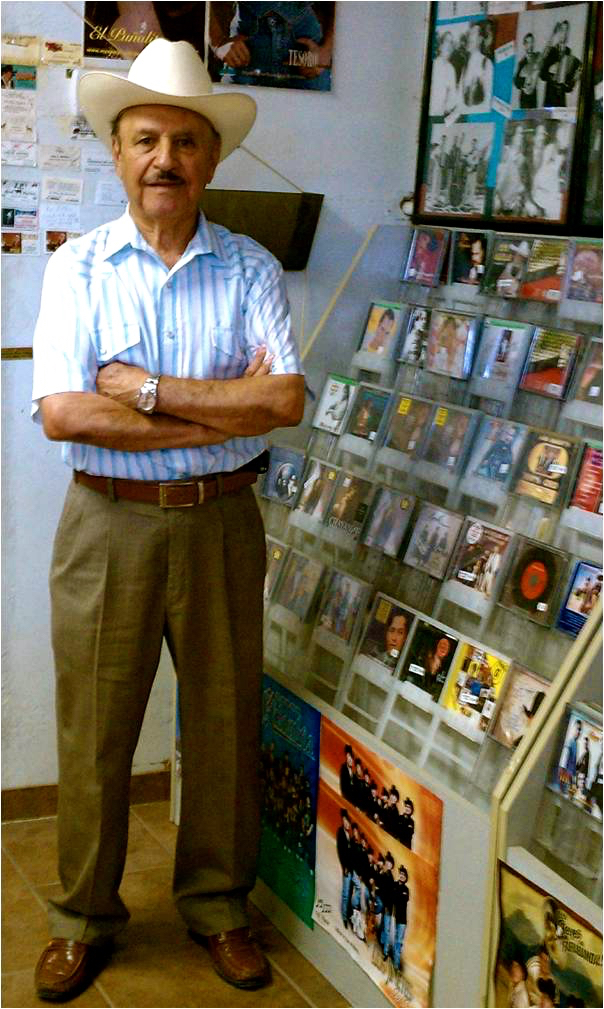 In 1976, Cavazos appeared with Conjunto Tamaulipas in the Les Blank/Chris Strachwitz documentary Chulas Fronteras, the seminal documentary on conjunto and norteño music. The film opens with Cavazos delivering a classic interpretation of “Canción Mixteca,” the nostalgic song of immigrant yearning for the homeland.
In 1976, Cavazos appeared with Conjunto Tamaulipas in the Les Blank/Chris Strachwitz documentary Chulas Fronteras, the seminal documentary on conjunto and norteño music. The film opens with Cavazos delivering a classic interpretation of “Canción Mixteca,” the nostalgic song of immigrant yearning for the homeland.
After Mario Montes passed away on January 28, 1993, Cavazos went on to perform with other outstanding accordionists, including Rene Maciel, Juan Antonio Coronado, and Beto Espinosa, in various incarnations of Los Donneños. In 2007, at age 80, he was inducted into the Texas Conjunto Music Hall of Fame.
For the next decade, the octogenarian could still be found behind the counter at his record store on South 23rd Street in McAllen. And he continued to perform.
In 2010, Cavazos participated in a recording that brought together other veteran stars of the norteño genre, including Hector Montemayor, Lorenzo de Monteclaro, and Poncho Villagomez, calling themselves Los Amigos Desde el Rancho. The CD, entitled La Antología de La Música Norteña, features Cavazos on his own composition, “Enseñate a Perder (Learn to Lose).” The studio recording was followed by a live performance on a separate disc, Los Amigos del Rancho, Vol. 2, Live At Allende Nuevo León. It includes another Cavazos composition, looking at heartbreak from the losing side, “Enseñame a Perder” (Show Me How to Lose).
On February 16, 2019, Cavazos celebrated his 92nd birthday with a backyard concert, captured in a homemade video posted to the band’s Facebook page. In the clip, he performs one of Los Donneños’ most famous songs, “Mataron a la Paloma,” which Cavazos co-wrote with Basilio Villiareal, “their old compadre,” as Strachwitz calls him. The tune is a tongue-in-cheek torch song about a heartbroken man who sends a message to his lost love via messenger pigeon; tragically, the bird is killed before completing is mission, so the woman never learns that the man is sorry and wants her back. In the song, he says he’ll never forgive himself for trying to save himself a stamp with mail service being as good as it is.
Mataron a la paloma que te llevaba el recado,
Por eso siempre pensaste que yo te había abandonado.
El recado se quedó en el pico de una loma,
Allí prietita querida, mataron a la paloma.
Por eso aunque pase el tiempo no me podré perdonar,
Que habiendo tan buen correo, con quién te lo fui a mandar.
En él te contaba todo, pidiendo que regresarás,
Que perdonarás mis faltas y conmigo te casarás.
Por eso aunque pase el tiempo no me podré perdonar,
Que habiendo tan buen correo con quién te lo fui a mandar.
Por ahorrarme una estampilla, maldita estampa, la mía!
“Ramiro Cavazos is an icon and a legend in his own style that only he can produce," Lupe Saenz, president of the South Texas Conjunto Association, told The Monitor. “His compositions are constantly being recorded by conjuntos because they know that his songs are quality compositions. Composers like Mr. Cavazos are few and far between.”
– Agustín Gurza
7 Comments
Stay informed on our latest news!
Los Donnenos artist biography
by Diana Pulido (not verified), 05/31/2023 - 14:04Trying to order the bio on my dad Mario Montez
MUSICA NORTEÑA
by JOSE NARCISO GO... (not verified), 03/26/2023 - 05:21ME ENCANTA LA MUSICA DE LOS DONNEÑOS. SOY DE MICHOACAN, PERO EN UN VIAJE A MCKALEN, VISITE LA DISCOTECA DE DON RAMIRO, DONDE TUVE LA DICHA DE QUE ME AUTOGRAFIARA DOS DISCOS (UNO DE ELLOS NI CRUZ NI PUÑO DE TIERRA). DON RAMIRO ES UNA EXCELENTE PERSONA Y AMABLE CO.MO NINGUN OTRO. EN LA VISITA PUDE DARME CUENTA QUE LO VISITABAN VARIOS TEXANOS Y TOMABAN SU CAFÉ. FUI UNAS DOS VECES A SU TIENDA, Y SIEMPRE HE EXTRAÑADO NO VOLVERLO A VER , PERO SIEMPRE LO LLEVO E MI CORAZÓN A LA VEZ QUE ESCUCHO SUS CANCIONES DE LAS TENGO POR CIENTOS. UN ABRAZO A DON RAMIRO DONDE QUIERA QU SE ENCUENTRE. GRACIAS.
Extrañando los Buenos Tiempos de Antaño
by Zahuastipan (not verified), 07/21/2021 - 16:37Muy buenas canciones. Ojalá volvieran esos tiempos de los años 40s y 50s.
La vida era más sana y limpia y con una música bonita que todos escuchaban. Después de volver de la milpa, los señores en ocasiones escuchaban está música de Los Donneños y también de Los Alegres de Terán. Eran muy grandes estás dos agrupaciones.
Ojalá regresaran esos tiempos de los 40s y 50s.
Information on last name spelling
by Martha Montez H... (not verified), 07/15/2021 - 14:10Dear Agustin,
Regarding the spelling of my last name:
My father Mario spelled his last name "Montes", which is the correct spelling. I have 4 siblings and the only one that got it put in right on his birth certificate was my oldest brother Mario Montes who is also a musician (Romance from the 80's). Thank you for your prompt attention to this matter. If there's any other information that you require at some time in the future, please let me know. Thank you
Martha A. Montez Howton
Response to Inaccurate Information
by Agustin Gurza, 07/13/2021 - 20:22Dear Martha:
Thank you very much for contacting us and bringing these issues to our attention. The new information you provide helped us to correct the historical record and to make the biography more worthy of your father’s memory and his significant cultural contributions.
Please allow me to expand on the points you raise.
1. Date of Death.
Unfortunately, this error highlights the lack of authoritative, reliable sources when it comes to researching Mexican American music, especially that of grassroots groups like Los Donneños. There are contradictory dates given for your father’s death, even from sources normally considered reliable.
In fact, an incorrect date appears in the liner notes for the compilation CD, “Los Donneños: Grabaciones Originales 1950-1954 / Historic First Recordings (Arhoolie 9057). The text of the 2006 CD release indicates that “accordionist Mario Montes died in November of 1991.”
Another incorrect date, the one I relied on, was published by El Extra, a Spanish newspaper operated by El Nuevo Heraldo, based in Brownsville, Texas. That 2014 article, “Los Donneños: pilares de la música norteña,” was penned by a music writer named Sergio Lozano, identified in his byline as “La Pluma Musical” de El Extra. Lozano wrote: “El 17 de enero de 1994 murió Mario Montes y fue cuando Ramiro Cavazos optó por seguir la música haciéndose acompañar por acordeonistas extraordinarios.”
I used that date because it was precise and was published in a respectable local newspaper by an author credited as knowledgeable within a somewhat detailed article that appeared authoritative. I regret the error.
Thanks to you, I checked again and confirmed the correct date you cited in your message. My Ancestry website yielded a Social Security record with the correct information, as follows:
Social Security Death Index, 1935-2014
Name: Mario Montez
SS Number: xxx-xx-xx37
Birth Date: 30 Nov 1923
Issue Year: 1967
Issue State: Texas
Residence: 78537, Donna, Hidalgo, Texas, USA
Death Date: 28 Jan 1993
2. MARRIAGE and OFFSPRING
I have no one to blame for this error but myself. There are plenty of web sources with the same correct information as you provided. Unfortunately, I inadvertently turned the relationships upside down in my text. I sincerely regret the error. Spurred by your message, I checked and found an official record of the marriage of your parents, Mario Montez and Alma de la Garza, on Feb. 25, 1951. The certificate from the County of Hidalgo is available on Ancestry, although I’m not sure if you need a subscription to view it. My article has been updated to reflect the correct information
In a separate matter, I hope you can clarify a question about the spelling of your father’s surname. In most of his credits he’s listed as Montes, with an “s.” In the Frontera archive, for example, he has 46 composer credits for songs by Los Donneños as M. Montes. But there are a couple of credits which use Montez, with a “z.” It’s interesting that the two official records I mentioned from Ancestry also use the same spelling, Montez, and you do as well. Was there a change to the proper spelling at some point?
Once again, thanks for your help in correcting the record. We strive to maintain the highest level of accuracy possible, and you have helped us meet that goal.
Agustín Gurza, Editor, The Frontera Collection
Inaccurate information
by Martha Montez H... (not verified), 06/13/2021 - 16:43I'm the daughter of Mario Montez. My father Mario Montes married my mom Alma De La Garza. My sister Diana Montez Pulido is the wife of " Tejano saxophonist Roberto Pulido", making my sister the mother of Bobby Pulido. This is one inaccuracy in the article. The second inaccuracy is the date of my father's death. He passed away January 28, 1993.
I would love to see this information corrected.
Respectfully
Martha Montez Howton
Family Tree of Don Ramiro Cavazos
by Gilberto Gonzales (not verified), 09/27/2019 - 10:15I'm now 64 years old and I was told by uncles that Don Ramiro had a cousin named Manuel Cavasos who married Christina Gonzales. I would like to know if this information is correct.